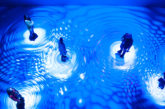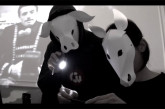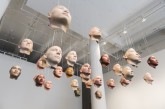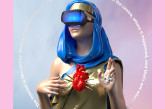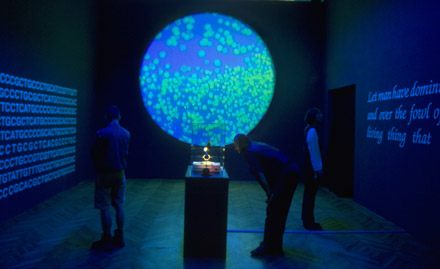
Bio art is a new direction in contemporary art that manipulates the processes of life. Invariably, bio art employs one or more of the following approaches: 1) The coaching of biomaterials into specific inert shapes or behaviors; 2) the unusual or subversive use of biotech tools and processes; 3) the invention or transformation of living organisms with or without social or environmental integration. It is in the latter, however, that it reveals its most radical vector, precisely because it works in the living —that is, living in the most ordinary sense of the word, from a single cell to a mammal. It is in this organic sense that bio art uses the properties of life and its materials, changes organisms within their own species, or invents life with new characteristics. Bio art stakes evolutionary strategies that offer alternatives to mainstream notions of beauty (imagine a pink-spotted turquoise rose with thorns on its leaves) or singularity (imagine a photosynthesizing mammal). It may coax inert and isolated biological byproducts into unprecedented forms (visualize an entire nanoscopic city built of DNA molecules and isolated proteins) and function (consider a molecular poetry written for the umwelt of bacteria). Bio art intervenes in the lineage of existing organisms through random approaches (seed scattering to provoke cross-pollination with wild plants) or rigorous breeding programs (backward or forward breeding to isolate specific characteristics and thus create a distinct being). Bio art may make marginal naturally occurring mutations the foundation of a given practice, thus undermining its secondary evolutionary status. It can provoke somatic or germline changes in organisms, or simply use their properties in unexpected ways. Theoretically, many biological artworks may last as long as life exists on the planet, provided that they remain capable of replication or reproduction. Ultimately, it is possible to envision a future in which the atomic synthesis of life will be possible, that is, the creation of new life forms one atom at a time. Conceivably, should astrobiology ever reveal the existence of life outside the Earth, yet unfathomable possibilities might emerge for art. Bio art should not be seen as limited to present-day understanding and techniques, but rather as a general principle of literal life-based creation.
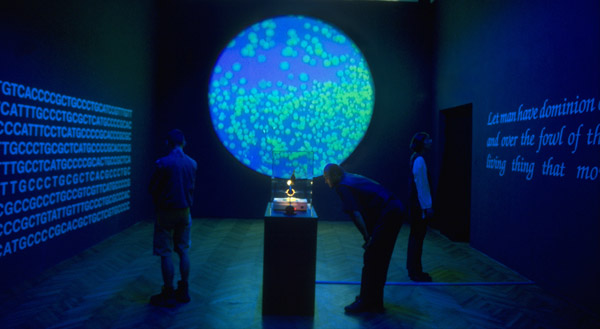
Installazione transgenica, 1999
While “life” can be understood in many ways, living organisms are carbon based and go through a process that can be very roughly summarized as birth or generation, the possibility of reproduction or replication, and death. From a stricter biological point of view, living organisms can be considered at the level of their genetic makeup, form, metabolism, growth, reproduction and response to stimuli. If considered in a larger social or environmental context, it is necessary to take into account subjectivity, cognition, symbiosis, communication (from molecular to audiovisual), cultural patterns, and the interaction with the environment (in what Maturana and Varela called “natural drift”, the theory according to which evolution does not take place through optimal adaptation of the organism to a given environment, but rather through mutual interaction between organism and environment, with organisms naturally drifting in the environment) [1]. All of the above are of interest to bio art.
As is always the case with any art practice or movement, what makes bio art unique is not what it may share with other forms (for example, ecological art), but what it brings to contemporary art that was not there before (a focus on the fundamental process of life, genetics and biotech media). Thus, it is useful to highlight its distinct traits by comparing it to areas often confused with it or misrepresented as identical in scope. Bio art must be clearly distinguished from art that exclusively uses traditional or digital media to address biological themes, as in a painting or sculpture depicting a chromosome or a digital photograph suggesting cloned children. Bio art is in vivo. In the present it still can be understood as different from the use of computers to simulate evolutionary processes in silico, although the distinctions between biological simulation and actuation might collapse in the future. Further, in its specificity bio art cannot be classified as ready-made, conceptual art or social sculpture. Although some artists occasionaly employ these forms, they do so not as the focus of their activity, but subsumed under a larger experimental biological program.
As I stated above, bio art creates not just new objects, but more tellingly, new subjects. Unlike conceptualism, which highlighted the use of ideas, language, and documentation of events, bio art emphasizes the dialogical and relational (e.g.: cross-polination, social intercourse, cell interaction, interspecies communication) as much as the material and formal qualities of art (the shape of frogs, the color of flowers, bioluminescence, the patterns on butterfly wings). While modern and contemporary art have produced objects (painting, sculpture, ready-made), environments (installation, land art), events (performances, happenings, telecommunications exchanges), and immaterial works (videos, digital pieces, web sites), bio art has as its core “materials” ontogeny (organism development) and phylogeny (species evolution, and opens itself to the entire gamut of life processes and entities, from DNA molecules and the smallest virus to the largest mammal and its evolutionary lineage. Under certain circumstances, the work of those involved with ludic scientific investigation can also be relevant to bio art. A few artists explore bacteria, while others work directly with proteins and genes. While certain artists manipulate plants, different groups delve into tissue culture. Some develop breeding projects or somatic modifications. The typical apparatus found in laboratories can also be subverted and put to new uses. Other artists focus less on an organism or material and more on a general approach, such as biological irreverence or the creation of new life through transgenesis.
Bio Art has very few historical antecedents. In 1936 Edward Steichen would hold the groundbreaking exhibition of flowers of his own creation at the Museum of Modern Art, in New York. Better known for his photographic work, Edward Steichen was the first modern artist to create new organisms both through traditional and artificial methods, to exhibit the organisms themselves in a museum, and to state that genetics is an art medium. To create his flowers (delphiniums) he hybridized them by hand but also employed chemicals to provoke mutations. In what amounts to a manifesto for a genetic art, Steichen wrote: “The science of heredity when applied to plant breeding, which has as its ultimate purpose the aesthetic appeal of beauty, is a creative art.” [2] In keeping with the artist’s desire for art to be accessible to everyone, Steichen’s genetic art can still be purchased from Burpee.com at the price of $2.95 for a packet of 50 seeds. Steichen’s breakthrough — the understanding of biology as a medium, and not just as theme or abstract reference — would not have continuity until the late 1970s, when George Gessert started to hybridize and create his own Irises as a form of contemporary art. Contemporary bioartists include David Kremers, George Gessert, Heather Ackroyd/Dan Harvey, Oron Catts/Ionat Zurr, Marta Menezes, and Eduardo Kac.
Artists whose work involves the direct transformation of living organisms, or the creation of new life, ought to realize that their efforts no longer take place in the well-defined domain of objecthood — but rather in the more complex and fluid zone of subjecthood. Subjects are alive, free and autonomous. From bacteria to bunnies, from frogs to flowers, living organisms grown or bred in unique ways, modified or invented by artists are the elements of a true art of evolution.
The fine balance between engagement and critique that bio art crafts enables it to carve an autonomous space, that is, separate from the nearly indistinguishable domains of biotech research and industrial application. By the same token, as an art of evolution, an art of life or existence, it affects, or has the potential to affect the world in unprecedented tangible ways. The Steichen Strain is still planted today. Will we find seventy years from now Gessert’s irises in a catalogue, Kramer’s bacterial paintings evolving new forms, or Menezes’s butterflies rendered in germline variety? Will Symbiotica’s synthetic but organic, semi-living stakes become an industry standard? Will they become NASA’s solution to feeding Mars colonizers, as current space research suggests? Artists working with the tools of the biotechnology age grapple with the complexity of life, that is, the interaction between genetics, organism, and environment. They resist biological determinism and reductionism, and demonstrate the fragility of the objective edifice of science. They also invent new entities and new relationships never seen before.
Eduardo Kac
D’ARS year 49/nr 197/spring 2009
NOTES
1 – Humberto Maturana and Francisco Varela. Tree of Knowledge: The Biological Roots of Human Understanding (Boston, MA.: Shambhala Publications, 1992), 94-117. Originally published as : El árbol del conocimiento (Santiago de Chile: Editorial Universitaria, 1984). See also: Francisco Varela, Evan Thompson, and Eleanor Rosch (op. cit.), pp. 200-205.
2 – Edward Steichen. “Delphinium, delphinium and more delphinium!” The Garden (March 1949).

